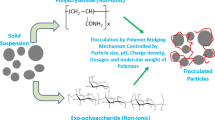Abstract
Polyaluminium chloride (PAC) synthetic water was selected as a coagulant and kaolin suspension particles as objects to be removed. Online instruments such as the turbidimeter and particle counter were employed to monitor the flocculation process online and collect test data. The aim of the experiments was to study the dynamic distribution characteristics of suspension particles in the flocculation process. The 3D flow field in the reacting vessel was also simulated at different slow stirring speeds. The experiments showed that particle collision and aggregation in the flocculation process is in compliance with the Sutherland cluster aggregation model. This study further indicated that under appropriate hydrodynamic conditions, the distribution of turbulent flow in the reactor could be improved to increase the odds of effective particle collision and restrain the breakup of formed flocs by vortex shearing force. A good flocculation effect could therefore be produced.
Similar content being viewed by others
References
Ceronio, A.D., Haarhoff, J., 2005. An improvement on the power law for the description of particle size distributions in potable water treatment. Water Research, 39(2–3):305–313. [doi:10.1016/j.watres.2004.09.023]
Cui, H.M., Zhang, S.X., Chen, K.C., 2004. Application of particle counter for the water treatment in Beijing No. 9 water plant. Water Purification Technology, 23:32–37 (in Chinese).
Bushell, G., Amal, R., 2000. Measurement of fractal aggregates of polydisperse particles using small-angle light scattering. Journal of Colloid and Interface Science, 221(2):186–194. [doi:10.1006/jcis.1999.6532]
Jarvis, P., Jefferson, B., Gregory, J., 2005a. A review of floc strength and breakage. Water Research, 39(14):3121–3137. [doi:10.1016/j.watres.2005.05.022]
Jarvis, P., Jefferson, B., Parsons, S.A., 2005b. Breakage, regrowth and fractal natural organic matter flocs. Environmental Science & Technology, 39(7):2307–2314. [doi:10.1021/es048854x]
Luo, Y.P., Li, N., Li, J.G., 2000. Testing and controlling suspended particles in drinking water. Water & Wastewater Engineering, 26:26–31.
Park, H., Kim, S., Chang, H., 2001. Brownian dynamic simulation for the aggregation of charged particles. Journal of Aerosol Science, 32(11):1369–1388. [doi:10.1016/S0021-8502(01)00063-5]
Sutherland, D.N., 1967. A theoretical model of floc structure. Journal of Colloid and Interface Science, 25(3):373–380.
Tang, S., Preece, J.M., Mcfarlane, C.M., 2005. Fractal morphology and break age of DLCA and RLCA aggregates. Journal of Colloid and Interface Science, 221(1):114–123. [doi:10.1006/jcis.1999.6565]
Wang, D.S., Chen, Y.S., 2003. Application of on-line laser particle counter in water treatment. China Water & Wastewater, 19:29–31 (in Chinese).
Wang, X.C., Tambo, N., 2000. A study on the morphology and density of floc (I): the fractal structure of floc. Acta Scientiae Circumstantiae, 20(3):257–263.
Wang, Z.G., Xu, Y.P., Cui, F.Y., 2006. Analysis on parameters of particle size distribution in drinking water treatment. China Water & Wastewater, 22:50–52 (in Chinese).
Yang, Y.L., Li, X., Cong, L., 2003. Optimizing of water quality monitoring and removal of pathogenic protozoa in water works. Water & Wastewater Engineering, 29:22–26.
Yukselen, M.A., Gregory, J., 2004. The effect of rapid mixing on the break-up and re-formation of flocs. Journal of Chemical Technology and Biotechnology, 79(7):782–788. [doi:10.1002/jctb.1056]
Author information
Authors and Affiliations
Corresponding author
Additional information
Project supported by the National Natural Science Foundation of China (No. 50678047), the Hi-Tech Research and Development Program (863) of China (No. 2006AA06Z305), and the National Science and Technology Project of Eleventh Five Years of China (No. 2006BAJ08B05-2)
Rights and permissions
About this article
Cite this article
Nan, J., He, Wp., Song, Jj. et al. Characteristics of the dynamic distribution of suspended particles in the flocculation process. J. Zhejiang Univ. Sci. A 10, 1350–1358 (2009). https://doi.org/10.1631/jzus.A0820652
Received:
Accepted:
Published:
Issue Date:
DOI: https://doi.org/10.1631/jzus.A0820652




